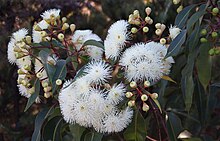Corymbia calophylla
| Marri | |
|---|---|
 |
|
| C. calophylla, near Cataby | |
| Scientific classification | |
| Kingdom: | Plantae |
| (unranked): | Angiosperms |
| (unranked): | Eudicots |
| (unranked): | Rosids |
| Order: | Myrtales |
| Family: | Myrtaceae |
| Genus: | Corymbia |
| Species: | C. calophylla |
| Binomial name | |
|
Corymbia calophylla (Lindl.) K.D.Hill & L.A.S.Johnson |
|
Corymbia calophylla, also known as Eucalyptus calophylla, is a bloodwood native to Western Australia. Common names include marri and Port Gregory gum, and a long-standing usage has been red gum due to the red gum effusions often found on trunks.
It is distinctive among bloodwoods for its very large buds and fruit, colloquially honky nuts, in Western Australia.
The Noongar peoples know the tree as gardan, kurrden, mahree, marri, nandap or ngora.
The tree, or rarely mallee, typically grows to a height of 40 metres (131 ft) but can reach as a high as 60 metres (197 ft). It has rough tessellated grey-brown to red-brown bark that extends over the length of the trunk and branches. Adult leaves are disjunct, glossy, green, thick and concolorous with a broad lanceolate to ovate shape that is basally tapered or basally rounded. The leaf blade is 9 to 14 centimetres (4 to 6 in) long and 25 to 40 millimetres (0.98 to 1.57 in) wide. The leaf petioles are narrowly flattened or channelled and 15 to 20 mm (0.59 to 0.79 in) long. It blooms between December and May producing white to pink flowers. The terminal compound conflorescence composed of three to seven flowered regular umbellasters on terete or angular peduncles. Buds form that are clavate and 7 to 14 mm (0.28 to 0.55 in) in length and with a diameter of 7 to 10 mm (0.28 to 0.39 in) with a calyptrate calyx. The fruits or gumnuts form later and can remain on the tree for a year or more. They are ovoid to urceolate in shape, pedicellate, and 30 to 50 mm (1.2 to 2.0 in) long with a 25 to 40 mm (1.0 to 1.6 in) diameter.
The large nuts produced carry large seeds which are an important food source for native bird species such as cockatoos. The tree propagates readily from seeds.
The species originally was first described as Eucalyptus calophylla by the botanist John Lindley in 1841 in the journal Edwards Botanical Register from samples collected by Robert Brown near King George Sound in 1801.
...
Wikipedia
